Abstract
Electric vehicles (EVs) and photovoltaic (PV) systems have been progressively incorporated into the grid in recent years principally due to two factors: reduced energy costs and lower pollutants. Numerous studies have investigated how integrating PV and EVs into the grid may affect specific people. It is crucial to understand that the electricity grid will experience the combined effects of PV–EV integration as PV and EV penetration increases. The primary motivation for PV’s integration with Vehicle-to-Grid (V2G) and Grid-to-Vehicle (G2V) services is the aim to reduce charging costs from discharging; moreover, another prerequisite must be satisfied before PV arrays will be able to provide V2G services. The range between the driving limit and EV battery degradation should be reasonable. The way EVs charge and discharge will be impacted by these factors. Numerous analyses are required in order to control the power between various source and load scenarios. In order to balance grids and manage frequency, controllers such as Improved Particle Swarm Optimization (IPSO), Improved Ant Colony Optimization (IACO), and Improved Mayfly Optimization (IMO) are used. As a result, V2G/G2V helps feed electricity back into the grid. By providing the proper duty cycle ratio, the proposed controller regulates converter switching. This study allowed for the performance analysis and operation simulation of a grid-connected PV/EV/Grid system. The purpose of this system was to maximize PV self-consumption while maintaining power quality characteristics like harmonics, grid voltage/current, and power factor.
1. Introduction
Fossil fuels dominate the world’s energy mix today, powering both the transportation and power producing sectors. The need for alternative energy sources for these industries is increased due to the depletion of fossil fuel stocks []. In actuality, the oil economy’s future, which is seen as being heavily dependent upon vehicle fleets throughout the world, is not only unsustainable but also extremely constrained []. Additionally, the introduction of electric vehicles (EVs) was prompted by the production of greenhouse gases (GHGs) from the combustion of fossil fuels, which have a significant impact on global climate change []. The most recent advancement in EVs is called V2G, which allows for the injection of electricity into the utility grid as required. Conventional EVs have a single operating mode, which is charging. They can also accept electricity from the grid and can run in both directions []. Better energy management with the grid is now possible due to the advancement of V2G technology, which includes the control of bidirectional charging and discharging. The early advances of V2G systems are mostly concerned with either charging methods or energy management. A smart house may serve as a domestic micro-grid thanks to its many generating resources, storage options, and regulated loads []; it can offer the grid support features such as DR or even real and reactive power injections. Due to the uncertainties created by loads and producing units, it is difficult to precisely assess the combined technical impact of solar panels and electric car charging stations in electrical grids []. In order to evaluate this combined impact in solar V2G, precise analytical methodologies are needed []. Using lithium-ion batteries, it was possible to sell as much capacity during one-hour windows of peak grid demand in an effort to increase an EV owner’s profit. However, the findings indicated that this increased battery use, even at constant power, is detrimental to the performance of the cells and might shorten the lifespan of battery packs to fewer than five years [].
Electricity demand and supply must be constant for charging stations to function properly, therefore the generation, transmission, and distribution capacity must be planned to handle any potential peaks in demand []. This was accomplished more effectively by combining renewable energy sources with the V2G services, which will enable automobiles to sell their batteries to the grid for extra energy []. The V2G makes it possible for automobile charge to serve as a portable energy storage system for RES, commonly referred to as green energy, which are produced utilising natural resources, such as solar radiation or wind or river currents, and are unpredictable to variable degrees. It gives a detailed and thorough review of the issue with a broad focus on V2G technology []. The system under investigation consists of a building model, a battery storage system, and PV generation []. During the periods of significant cost variations for power or while using large PV sizes, a sizeable storage capacity has been attained []. A battery and thermal storage system controlled by a procedure that promotes the use of grid electricity outside of peak hours and increases the PV self-consumption was designed []. An effective way to address potential issues connected to a large penetration of EVs and the resulting variability in the power supply is to integrate V2G technology with RESs and generators. In order to provide bidirectional V2G operation utilising EVs, this research proposes a unique control mechanism that will enable the V2G aggregator []. The power grid received frequency and voltage management services from the V2G, which reduced charging costs, increased operating benefits, and reduced battery deterioration []. This paper’s primary goal is to provide a thorough examination of the V2G and how it is integrated with RESs and generators in order to identify research gaps and provide guidance for future investigations. The discovery of 16 unique topics of research surrounding the V2G system by evaluating current publications and categorizing them based on their frequency and proposed approaches is what sets this work apart from other review papers—in addition to its accurate and in-depth literature review. This study’s findings are compiled and presented in a special table; additionally, we performed a review of the academic works from the past two decades as well as any initiatives and services that have been delivered in relation to the V2G system.
2. Literature Review
Peter K. Joseph and Elangovan Devara et al. [] demonstrated that Vehicle-to-Grid (V2G) integration supports renewable-energy-powered bidirectional power flow between the grid and the vehicle. The automated load sharing and grid control provided by V2G with wireless charging will increase system efficiency. Since the RES was weather-dependent, the sources have been impacted by climatic circumstances.
G. Guru Kumar and Kumaravel S et al. [] presented a brand-new non-isolated Dual-Input Single-Output DC-DC Converter (DISOC), which was created in order to use PV and carry out V2G operation. Loss reductions significantly contribute to obtaining greater efficiency when DISOC is compared to traditional topologies; however, if the converter is professionally developed and made at the industrial level, the power density may be dramatically boosted.
Lei Wang and Udaya K et al. [] created a Wireless Vehicle-Grid-Home Power Interface (WVGH-PI) using a grid-side low-frequency-to-DC converter. To reduce system losses when regulating power throughout various modes of operation, WVGH-PI employs a DC voltage control approach. The lack of naturally occurring freewheeling pathways, however, made this technique effectively necessitate a complicated switching algorithm and control mechanism.
Abdulgader Alsharif and Chee Wei Tan et al. [] developed a Rule-Based Energy Management Strategy (RB-EMS) to regulate the system’s power flow. RB-EMS delivers the precise response and moves swiftly to fulfill load demand at the lowest possible operational cost. To handle the aforementioned concerns in RB-EMS, several agreements have been made; however, this is due to the growing worldwide environmental problems and climate change.
Hamed Heydari-doostabad and O’Donnell et al. [] designed a wide-bandwidth, bidirectional DC-DC converter with high voltage gain, which was put into use for V2G and G2V applications. In comparison to other converters, the suggested model has several benefits, such as a wider voltage range and excess current—thereby producing a more useful and adaptable architecture. However, V2G does not have a common ground between the input and output, has a limited voltage range, and requires extra switches and capacitors.
Mikel Gonzalez and Francisco Javier Asensio [] presented the implementation of a control for an electric vehicle charger that provides Vehicle-to-Grid (V2G) services while decreasing the present Total Harmonic Distortion (THD). THD can be decreased by increasing the current loop gain of an EV charger control, although doing so may jeopardize the charger controller’s stability. However, in order to maintain the viability of the V2G, services should be taken into account since they increase the induced deterioration of batteries.
Wiebke Meesenburg and Andreas Thingvad [] developed main frequency regulation utilizing Electric Vehicles (EVs) and a large-scale heat pump to take advantage of synergies between the batteries’ capability for quick regulation. It is suggested that a large-scale heat pump is used to take advantage of how the thermal system’s huge heat storage capacity and fast-regulating batteries work together. However, large-scale heat pumps are normally designed for optimal energy efficiency and constant base-load operation, not for fast load changes.
Depending on a lot of driving and charging capacities, He Cheng et al. [] developed a complete Switched Reluctance Motor (SRM) for PHEVs. In order to correctly assess the braking and driving operations, the motor driving mode included four fundamental functions. Without the need for extra battery chargers, there are three ways of charging that are accessible for batteries. For the purpose of recharging the traction battery, a three-channel intermittent boost converter with PF modification capability was built using the SRM windings and related converter circuit. An integrated half-bridge impedance converter was employed—resulting in a larger loss—to recharge the additional batteries from the motor.
Ramos et al. [] developed a Control Technique to moderate the power ripple of a Single-Stage Isolated Converter for EV applications that involved on-board battery chargers. The suggested converter uses an interleaving strategy and Dual Active Bridge function to manage the flow of power and phase-shift. This work also presents a control technique for decreasing low-frequency power fluctuations in a design while retaining the overall weight and dimensions without adding any more components on the secondary side. However, this approach does not prioritize measures of efficiency and power productivity.
A special DC-DC architecture created by Mohamed Elshaer et al. [] enables a PHEV to utilise an electric grid to recharge its high-voltage battery. By coupling the transmitter coil of the inductive battery charger to the onboard reversible semiconducting charger of the rechargeable automobile, a single rectifier and tertiary complementary resistance are shared between the two modules. Since the two modules work together as a unit, the onboard circuitry’s overall size and complexity are decreased. The regulator, auxiliary gate, and transistor will be expensive, but they will prolong the lifetime of the converter. The battery still charged, but the voltage was too high to allow the battery to function.
Nam et al. [] suggested a revolutionary combined On-Board Charging (OBC) converter with vehicle and supplemental battery charging features. A theoretically encompassed converter would contain a bidirectional full-bridge converter with an operational clamp circuit, a composite LDC converter, a phase-shift full-bridge, and forward converter. To manage the fluctuation between the rectifiers and eliminate harmonic currents, an additional circuitry made up of a resistor was utilized on the square converter’s tertiary side. However, this architecture consists of additional machinery, and some arrangements involve numerous isolated DC supplies.
A single-stage isolated electric charger without an intermediary DC link was proposed by Denys Zinchenko et al. []. In this study, the developed converter was mounted on a separate current-source design with mild transistor switching for the voltage rating of the AC line. The performance characteristics set the adapter apart, with its uninterrupted power recharging mode reaching the best efficiency. To increase efficiency, the suggested design does away with the diode repossession characteristics found in synchronous power converters. However, this converter’s structure necessitates the use of a separate filter, which results in a low transient responsiveness and excessive output disturbances.
A new transformer-less design for converters with voltage management and a reduced switch load is demonstrated by Shahir et al. [] and may be a strong candidate for high-power, quick-charging battery chargers for electric cars. This study presents a detailed analysis of the two operating modes of the proposed converter, specifically the Continuous and Discontinuous Current Mode. Furthermore, the important inductances and design considerations for the proposed controller are also estimated. However, taking into account the diode delay, the output impedance will increase relative to the power that is shielded from the inclusion of the diode.
3. Research Gap
In technical aspects, the majority of the recharging methodologies displayed examine the influence of vehicles on the electrical network. An evaluation of the network’s strength, perception to variables, and susceptibility to disturbances should be done before defining the goals to be met. As a result, it would be feasible to identify the services that might assist the network more. In this regard, it is impossible to guarantee that a regulation solution is ideal for every network. In essence, a method is required that should enable the creation of a specific charging protocol by taking into account the requirements of every network and the life quality of the batteries, as well as enhancing the inputs of all parties involved. This idea has a wide range of applications, including domestic collective parking lots. The selection of the current controller is crucial. Decentralized approaches are more constrained even though they provide higher scalability and data privacy. On the other hand, communication is necessary for centralized techniques to be managed optimally. The current electricity does not have a data layer of this magnitude; hence, this connection is a drawback. However, a chance for its development has been found. Power electronics, namely the converters found in EV chargers, are known to negatively affect the system in terms of oscillation output. The existence of a controller will be crucial in the case of a large incorporation, and their impact must be carefully examined.
4. Brief Overview of PV-Grid-EV
According to daytime grid saturation, the uninterrupted charging of EVs is currently not possible. Users are uncertain due to charging disruptions. In order to address the issue of car charging, these findings indicate that grid-connected charging should be combined with battery and PV charging. The suggested technique is effective for delivering EV charging without any interruptions. The suggested system’s key advantage is its ability to quickly meet all EVs’ charging needs while also reducing the additional grid load. The control algorithm was created using a variety of optimization techniques. Figure 1 depicts an overview of the proposed model.
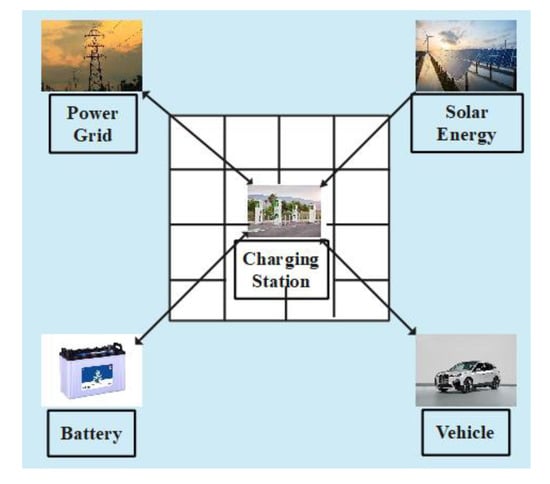
Figure 1.
Overview of proposed model.
The main justification for this is because continuous charging without taking into account V2G operations can overload the grid, particularly during the day. Additionally, V2G and V2V activities shorten the battery’s lifetime by increasing the number of charging cycles. This is why they are undesired for EV owners. To enable uninterrupted daylight EV charging without V2G and V2V operation, the suggested technique has been devised in this context. The placement of an office parking lot during the day is taken into account in the simulations that were run in this work to determine how well the suggested charging strategy would perform. Additionally, the controllers aid in easing the pressure of additional EV charging on the electrical grid. Figure 2 depicts a quick flow diagram of the overall procedure.
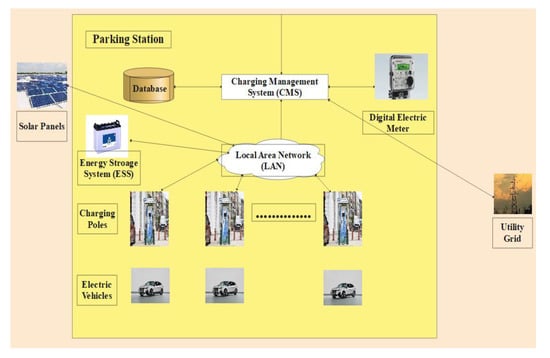
Figure 2.
Brief diagram of overall process.
The overall process is separated into three modules.
4.1. 1st Module (PV-to-Grid)
Figure 3 shows the process of the 1st module. In this module, PV is acting as a source side, while the distribution network (grid) acts as a load side. The power flow is generated from the source PV to grid load.
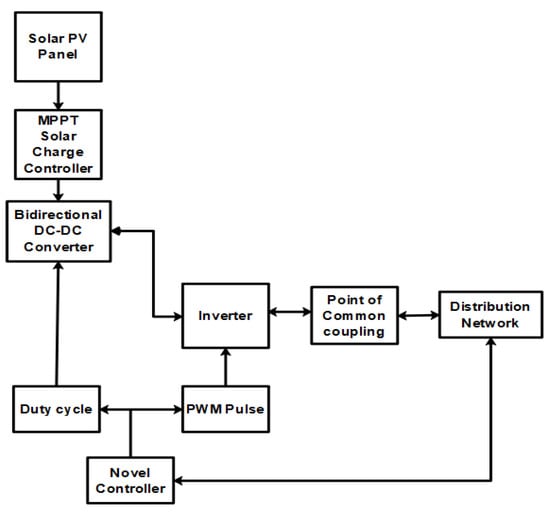
Figure 3.
Process of PV-to-Grid.
- Initially, PV produces the power, which completely depends upon the irradiation and temperature. Furthermore, MPPT tracking is used to extract the maximum power from the PV panel.
- The power is extracted from the PV, which is given as the input to the bidirectional DC-DC converter.
- This converter improves the voltage level up to a certain level, which depends on the specification. The main theme of the converter is to stabilize the value.
- The improvement in voltage completely depends on the duty cycle ratio, which is decided by our controller.
- After receiving the stabilized value from the converter, which is given as an input to the inverter, the main purpose of the inverter is to convert DC to AC.
- After this conversion, it is connected to the grid through a point of common coupling.
- The controller side plays a major role in this work.
- The controller is going to decide the power flow by calculating the load demand. Once the power flow is done, the controller calculates the load demand, and it will trigger the switches as well as produce a proper duty cycle ratio to control the load demand.
- The major impact in this scenario will be error harmonics—which will be produced on the load side—as well as power factor issues, voltage sag/swell, flickering, and the cost.
- On the solar side, the major impact will be loose connections, birds, roof issues, and potential-induced degradation.
4.2. 2nd Module (PV-to-Vehicle)
In this module, PV is acting as a source side, while Plug-in Hybrid electrical vehicles act as a load side, which is illustrated in Figure 4. The power flow is generated from source PV to EV.

Figure 4.
Process of PV-to-Electric Vehicle.
- Initially, PV produces the power, which completely depends upon the irradiation and temperature. Furthermore, MPPT tracking is used to extract the maximum power from the PV panel.
- The power is extracted from the PV, which is given as an input to the bidirectional DC-DC converter.
- This converter improves the voltage level up to a certain level, which depends on the specification. The main theme of the converter is to stabilize the value.
- The improvement in voltage completely depends on the duty cycle ratio, which is decided by our controller.
- After receiving the stabilized value from the converter, which is given as an input to the inverter, the main purpose of the inverter is to convert DC to AC.
- After this conversion, it is connected to the load, which is the EV.
- Same as the above, the controller will calculate the EV demand and produce the proper duty cycle as well as pulse to trigger the switches.
- Here, the major impact on the EV side is speed regulation, driving range, battery efficiency, state of charge, infrastructure (roads).
4.3. 3rd Module (PV-to-Grid-to-Vehicle)
In this module, PV acts as a source side, while Plug-in Hybrid electrical vehicles and the grid act as a load side, which is illustrated in Figure 5. The power flow is generated from the source PV to both the vehicle/grid.
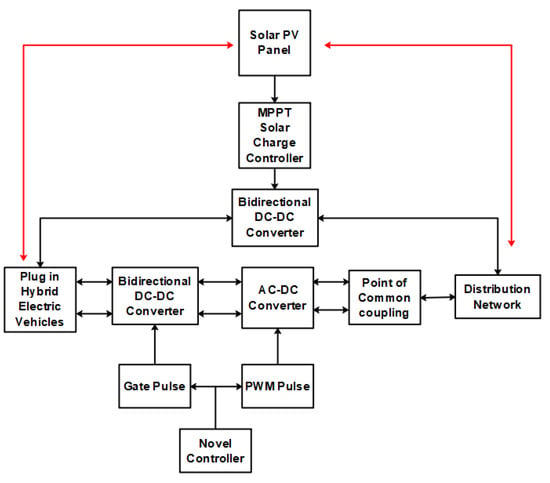
Figure 5.
Process of PV-Grid-EV.
- Initially, PV produces the power, which completely depends upon the irradiation and temperature. Furthermore, MPPT tracking is used to extract the maximum power from the PV panel.
- The power is extracted from the PV, which is given as the input to the bidirectional DC-DC converter.
- This converter improves the voltage level up to a certain level, which depends on the specification. The main theme of the converter is to stabilize the value.
- The improvement in voltage completely depends on the duty cycle ratio, which is decided by our controller.
- After receiving the stabilized value from the converter, the algorithm will check the load demand and distribute mutual power to both the grid and vehicle.
- The following are the methods that are used for the analysis, they are, IPSO, IACO and IMO. Those controllers follow the above-mentioned process and produces better results which is described in the upcoming section.
5. Methodological Analysis
5.1. Improved Particle Swarm Optimization (IPSO)
Improved PSO is a variation of PSO that offers better advantages for addressing optimization issues. The PSO algorithm now functions for these various kinds of problems as a result of the improvements. The ability of a bit to reach a value of one is the definition of velocity. PSO appears to be a more advantageous choice for boosting distribution system effectiveness. Consequently, IPSO is established and verified to expand system constancy through loss minimization [].
Similar to other swarm-based evolutionary methods, PSO uses a swarm. Each possible solution, or particle, moves around the multidimensional issue space at a velocity that is constantly changed based on its own and its teammates’ flight experiences []. PSO is an intelligent iterative technique where each particle’s velocity and position are determined, as shown below:
where are defined as acceleration terms; and is stated as personal and global best; is referred as particle current location; is stated as particle velocity; ω is quantified as the inertia weight factor, which is calculated in Equation (2):
where is specified as the iteration count. Additionally, Equation (3) represents the updated position as:
where is demarcated as the logistic transformation that is stated in Equations (4) and (5):
PSO has proven to be able to swiftly and effectively tackle complicated constrained optimization problems without any size or physical computer memory limitations. For the sake of reducing the problem’s size, vehicles are stated as signed integer numbers rather than 0 or 1. The number of charging/discharging grid-capable vehicles in a restricted system can be maximized by using a typical discrete form of PSO, which has less balance between local and global searching abilities. As a result, the maximum increase or decrease in value between two generations is constrained by Equation (6):
where the constriction factor is defined as, and δ is referred to as the acceleration rate.
5.2. Improved Ant Colony Optimization (IACO)
Improved Ant Colony Optimization [] is examined here using several ants to construct comprehensive solutions using heuristic knowledge of the function. During each iteration of the method, each ant moves from a state to state , which relates to a more complete intermediate solution. Using the Formula (6) equation, the ant from state to state is chosen from the list of unvisited states that has memorised:
Additionally, the ant moves from state to state with the probability of as shown in Equation (7):
Here, the transition probability is denoted by , the pheromone concentration τ (r, u) between and in the ith population η (r, u) is denoted by and the length of the trail between states r and u is denoted by . is the collection of unexplored states for the ant in the ith population, and are control parameters, and q is a uniform probability between [0, 1].
In general, choosing the correct parameter values to create an improved ACO algorithm with speedy convergence while avoiding premature convergence is difficult. Using a multi-population method, the ACO algorithm [] is improved. This strategy will separate elite ants from common ants. The elite ants have access to solution archives and can generate solutions by employing a Gaussian kernel function and a probability selection technique. Common ants are used to generate new solutions at a slower rate by adopting a single Gaussian function and the average value of each dimension in order to avoid settling for a local optimal value. The Gaussian function of a typical ant is described as follows:
where the estimated standard deviations, , and , and dimension, , dimension, while is a constant used to regulate the common ants’ pace of convergence. Common ants can effectively broaden their search area and increase their capacity for global exploration. Additionally, for improved capacity, the fitness function’s design maximizes the likelihood of heuristic path switches. A two-stage pheromone update technique is utilized to determine the best value in order to increase the pheromone value for the specific path and prevent the algorithm from attaining a local optimum.
5.3. Improved Mayfly Optimization (IMO)
The male mayflies will perform better in augmentation as well since they are consistently strong []. The MO approach moves the variables’ positions in accordance with their current positions , using the same optimization algorithm settings and velocity, , at the current epoch. Equation (11) should be used to move the positions of all of these mayflies. In contrast, its velocity could change in a variety of ways.
The velocity has been modified by actual fitness and best fitness in the previous motions .
If the previous optimal motions are declared in Equation (12):
where is declared a variable; and are referred to as stable. The Cartesian spacing is referred to as , which is declared in Equation (13)
If the non-systematic dance component , which is mentioned in Equation (14), suggests that male mayflies possibly update their velocity from their actual state.
where is declared as an indiscriminate quantity. Mayflies [] were able to distinguishably alter their motions. In order to breed, it was eager to make contact with male mayflies. The lifespan of female mayflies ranged from one to seven days, and they lacked wings. Additionally, they could alter their speeds based on which male mayflies they wanted to engage with. The MO method claimed that the most physically fit female and male mayflies had to reproduce first; moreover, other female and male mayflies may have followed suit, etc. Therefore, If , Equation (15) is written as,
where is declared as an alternative constant and the Cartesian distance is declared as .
If until the current one runs through more dance coefficients, the female creatures change their motions; given this, is written as Equation (16):
where the indiscriminate values are stated as . The mayflies in the top half can reproduce and produce two or even more offspring. The language used in Equations (17) and (18) suggest that the rate at which their progeny can depart from their mothers can be arbitrary,
where is represented as a Gauss distribution; moreover, Equations (14) and (16) show how swarm members’ velocities might fluctuate randomly under some circumstances. In the other cases, efficient systems could be used to alter the velocities. Equations (12) and (15) adjusted specific velocities by applying balanced current velocities and an incremental weighted distance from them to the overall correct option, which were the previous best movements—or their spouses. Equation (19) demonstrates that with additional context, the portions of the corrected distance appear as follows:
In order to accommodate for such a circumstance, Equation (19) must be modified, as shown in Equation (20):
6. Results and Discussion
This research uses MATLAB programming to verify the experimental findings. The assessment for PV-Grid-EV is developed and assessed using MATLAB R2021b, version 9.11. It has an Intel Core i7 processor, 16 GB of RAM, 64-bit and Windows 11. In this work, multiple methods for charging EVs throughout the day using a charging station based on a PV-Grid combination are discussed. The suggested plans assist the charging station in offering continuous charging. The findings demonstrate that, in contrast to conventional grid-alone charging, EV charging using the PV-Grid-EV combination and the suggested technique continues uninterrupted throughout the charging period. Figure 6 shows the full Simulink representation of the total analysis.
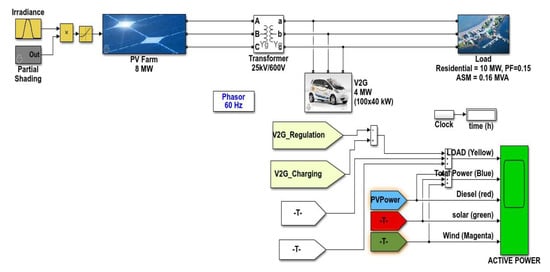
Figure 6.
Simulink model for overall analysis.
In the initial stage of this process, MPPT is used to track the MPP of the PV panel by adjusting the duty cycle of the converter to meet the required load at a constant output voltage. Therefore, a boost converter is employed to increase the voltage and a new duty cycle value will be produced, thereby directing the PV to a new MPPT point. Given this, the MPPT value will change according to the connected load. Table 1 shows the result of the MPPT precision values along with MPP power.

Table 1.
Comparative analysis of various controllers in terms of PV source.
Table 1 indicates that the maximum power achieved by every controller, wherein the IMO controller achieved 90.57 kW, which is much better than the IPSO and IACO controllers; moreover, the IPSO controller had a maximum power of 76.12 kW and the IACO controller had an MPP power of 81.44 kW. Given this, the recommended IMO controller has an improved precision of 99.12%, which is superior to other controllers. Figure 7 displays the performance of the PV source in terms of generated power and MPP power with the help of the IPSO, IACO, and IMO controllers.
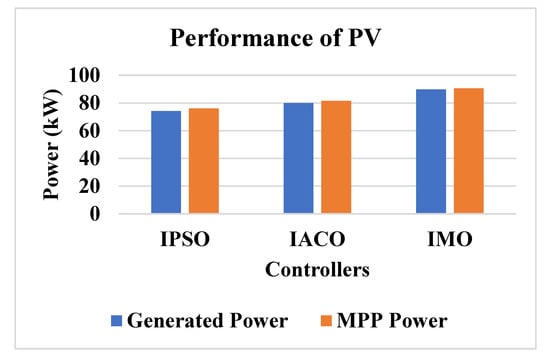
Figure 7.
PV power for IPSO method.
It is essential to incorporate various features, including active power filtering and power factor modification, into the voltage source inverter to improve this system. Non-linear loads connected to the grid produce current harmonics, which reduces the quality of the power. Active power filters are used to compensate for these armature currents. Problems with voltage regulation may surface when PV is connected to the grid.
Figure 8 displays the voltage, SOC, and current waveform performance analysis for an EV. The SOC of a battery, i.e., its remaining capacity, is determined using a discharge test under controlled conditions. The voltage method converts a reading of the battery voltage to the equivalent SOC value using the known discharge curve (voltage vs. SOC) of the battery. Accurate SOC estimation not only reflects the battery’s remaining capacity but also effectively prevents battery risks in advance. Further, it ensures the safety of clean EVs and human life. In order to prevent the expensive voltage-regulating equipment from degrading, the converters should deliver high-quality and dependable voltage. The ideal organization for battery presence is determined by using the computational method presented in this paper, which predicts numerous inverter designs. The SOC calculation provides some protection against unforeseen disturbances and keeps the batteries from being overcharged or discharged, which would harm the interior pre-arrangement of the batteries.
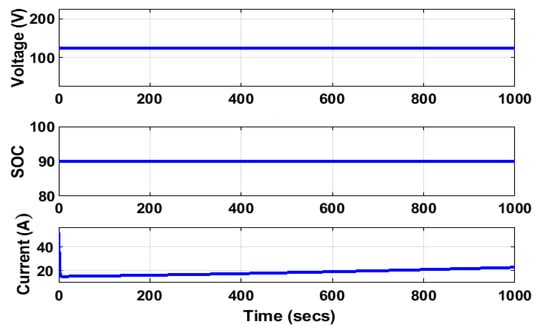
Figure 8.
Performance analysis of voltage, SOC, and current waveforms for electric vehicles.
Table 2 shows the THD, power loss, and efficiency findings of several controllers. Three different controllers for the delivery of grid services were quantitatively evaluated in order to analyze the dispatching of grid service efficiency. When the efficiency curve from experimental data is taken into consideration in the algorithm, the results show an enormous decrease in losses. For the high efficiency method, the simulation results produce relative losses of around 9.4% for IMO, which is better than the IPSO and IACO—whose losses are 8.6% and 8.9%, respectively. Further, it gives additional functionality on the load side and provides adequate charging circumstances for lower voltage profiles.

Table 2.
Performance analysis of various controllers in terms of EV.
The analysis of THD and power loss is shown in Figure 9. The MATLAB efficiency calculation is shown in Figure 10. To calculate the speed of computation, the condition of insufficient PV power was simulated, wherein a current restriction was set to the motor interface converter. The battery energy storage system will automatically provide the remaining load power as the PV array grates less power to allow the current command to reach the predetermined limit. The EV battery is configured as the load while receiving a constant current during charging. The motor driven speeds that have been set initially are 6000 rpm >> 5000 rpm >> 4000 rpm. The current reaches its maximum limit as the speed decreases from 5000 rpm to 4000 rpm. The remaining demand is then supported by the battery energy storage system. Over a wide speed range, the analyzed computational speed results in an enhanced motor efficiency, which is described in Figure 10.
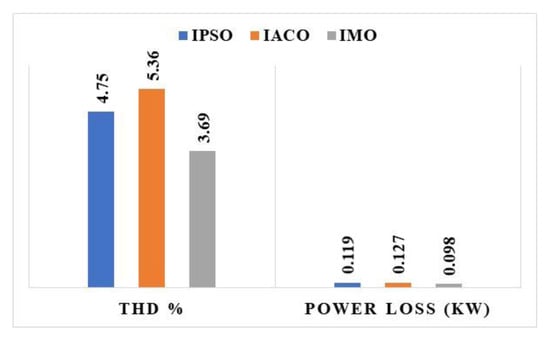
Figure 9.
Performances of THD and power loss.
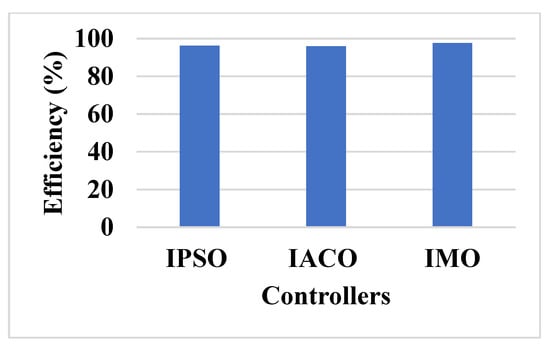
Figure 10.
Performance of efficiency.
In the design process, the DC-link voltage does not need to be increased above the input voltage. The suggested charger arrangement can maintain the efficiency throughout the second phase to produce an extremely wide output voltage scope. By calculating the efficiency using this architecture, one can determine whether circuit components are operating within their requirements. Given the simultaneous power dissipation of every component in the Semiconductor Devices library, a select few are represented via an internal variable. This instantly dissipated energy only includes the actual power that the block may dissipate. Using the log numerical model, the time-value series for this variable represents the power consumed by the component over a period. Since the losses for modules with a power consumed value are known, this efficiency function calculates the circuit’s efficiency. The grid voltage and grid current constraints are specified in Figure 11a, while Figure 11b shows the zoom view of the grid parameters. The device generates an excessive amount of renewable energy under various illumination situations by creating an increased grid current and voltage. First, MPPT selects MPP to utilize various controllers. Additionally, the peak loads can be managed with the predicted RES using the controller. The framework that emerged was mostly made up of realistic, in-depth simulations of the results from testing, which were both secure and difficult. The system has also been used to examine RES with an active change in behavior.
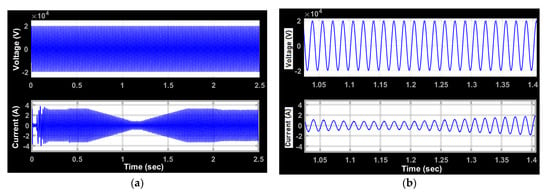
Figure 11.
(a) Grid parameters of voltage and current. (b) Zoom view of grid.
Figure 12 shows the discharge curve of the voltage from the charged to discharged state. As shown in Figure 12, the voltage curve of a battery during charging/discharging contains three main processes: an exponential drop from full charge as the battery begins to discharge, a nominal section about the rated voltage where the battery is typically operated, and a discharge section where the battery approaches its completely discharged state. It can be seen from the figure that the exponential voltage drops sections of the batteries have wide areas depending on the battery. The parameters gathered from the discharge characteristics are usually assumed to be the same for charging when the electrical model parameters are determined.
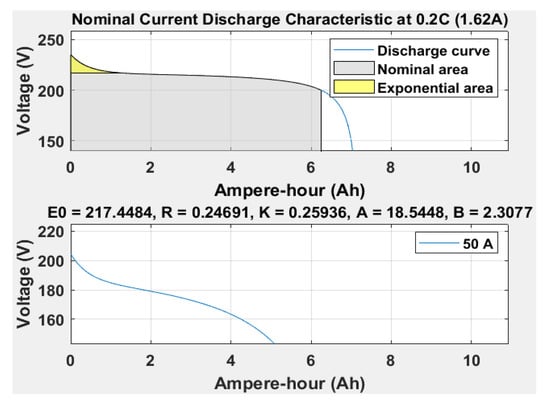
Figure 12.
Characteristics of discharge current.
Comparative Analysis
The existing SRM [] needed extra components, including converters or diode bridge rectifiers. The charger design’s two most important components are the converter and rectifier. There are not any additional components developed in the present charger architecture because it is smaller, cheaper, and smaller than the previous battery chargers. The integrated topology in [] must be logged into separated plugs of engine coils and totally depends on non-linear machinery. When opposed to other controllers, the traction machine’s power loss is proficiently included. The THD assessment for the IMO controller is shown in Figure 13. Table 3 provides a clear assessment of the current method.
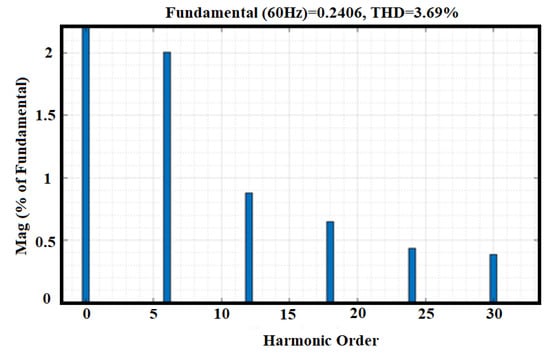
Figure 13.
THD analysis of IMO controller.

Table 3.
Comparative analysis of existing controllers.
The comparative analysis of efficiency and THD are illustrated in Figure 14. Despite the potential advantages of the various controllers, which is larger than the actual SRM power train architecture, the electrodynamic coupling of multiphase devices has an impact on the power factor []. The suggested techniques have a lower THD than the current techniques. While adopting the suggested control approach, the incorporated device maintains a similar recharging aspect despite the motor impedance settings for various integrated units, which vary.
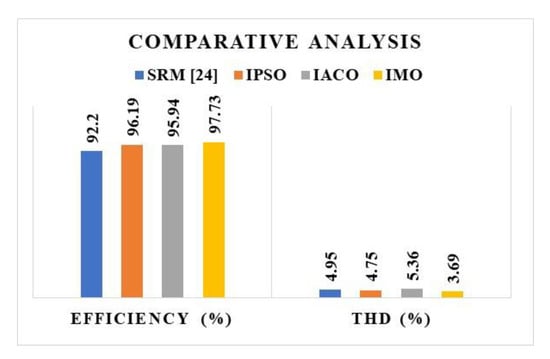
Figure 14.
Comparative analysis.
7. Conclusions
The Vehicle-to-Grid (V2G) infrastructure is created with the interaction of electric cars for this research. It has also been noted that electric cars may assist the grid with ancillary services such as frequency and voltage management, power leverage, and reactive power support to improve operational efficiency, lower operating costs, and secure the electric grid for the power system. According to the study, the use of communication, control, and metering technology would make it viable to incorporate into the smart grid system for electric vehicles (EVs). In this instance, the smart grid encourages the EVs ability to communicate with one another for grid assistance. This research looks at the relationship between the smart grid and EVs in greater detail. To support the V2G works adoption over the energy storage, an additional investigation and analysis are needed. Therefore, this research is analyzed with various controllers, such as Improved Particle Swarm Optimization (IPSO), Improved Ant Colony Optimization (IACO), and Improved Mayfly Optimization (IMO). From the results analysis, it clearly shows that the IMO controller achieved better results in terms of efficiency (97.73%), loss (9.4%), and Total Harmonic Distortion (3.69%) when compared with IPSO and IACO controllers. It is necessary to use modern technology in these fields to identify the difficulties and constraints in order to accomplish nearly real-time communication and power monitoring. In the future, this research will be further extended by analyzing grid-integrated photovoltaic and electric vehicles with various hybrid methodologies to improve the overall performance metrics.
Author Contributions
The paper investigation, resources, data curation, writing—original draft preparation, writing—review and editing, and visualization were performed by N.N. and M.A. The paper conceptualization and software were conducted by N.H. The validation and formal analysis, methodology, supervision, project administration, and funding acquisition of the version to be published were conducted by R.P.d.P. and P.B.D. All authors have read and agreed to the published version of the manuscript.
Funding
This research is supported by Spanish Research Projects P18-RT-4040 and PID2020-119082RB-C21.
Institutional Review Board Statement
Not applicable.
Informed Consent Statement
Not applicable.
Data Availability Statement
Not applicable.
Conflicts of Interest
The authors declare no conflict of interest.
References
- Hemmati, R.; Mehrjerdi, H. Investment deferral by optimal utilizing vehicle to grid in solar powered active distribution networks. J. Energy Storage 2020, 30, 101512. [Google Scholar] [CrossRef]
- Sangswang, A.; Konghirun, M. Optimal strategies in home energy management system integrating solar power, energy storage, and vehicle-to-grid for grid support and energy efficiency. IEEE Trans. Ind. Appl. 2020, 56, 5716–5728. [Google Scholar] [CrossRef]
- Mehrjerdi, H.; Rakhshani, E. Vehicle-to-grid technology for cost reduction and uncertainty management integrated with solar power. J. Clean. Prod. 2019, 229, 463–469. [Google Scholar] [CrossRef]
- Uddin, K.; Dubarry, M.; Glick, M.B. The viability of vehicle-to-grid operations from a battery technology and policy perspective. Energy Policy 2018, 113, 342–347. [Google Scholar] [CrossRef]
- Amamra, S.A.; Marco, J. Vehicle-to-grid aggregator to support power grid and reduce electric vehicle charging cost. IEEE Access 2019, 7, 178528–178538. [Google Scholar] [CrossRef]
- Heilmann, C.; Friedl, G. Factors influencing the economic success of grid-to-vehicle and vehicle-to-grid applications—A review and meta-analysis. Renew. Sustain. Energy Rev. 2021, 145, 111115. [Google Scholar] [CrossRef]
- Iacobucci, R.; McLellan, B.; Tezuka, T. Optimization of shared autonomous electric vehicles operations with charge scheduling and vehicle-to-grid. Transp. Res. Part C Emerg. Technol. 2019, 100, 34–52. [Google Scholar] [CrossRef]
- Alsharif, A.; Tan, C.W.; Ayop, R.; Dobi, A.; Lau, K.Y. A comprehensive review of energy management strategy in Vehicle-to-Grid technology integrated with renewable energy sources. Sustain. Energy Technol. Assess. 2021, 47, 101439. [Google Scholar] [CrossRef]
- Brenna, M.; Foiadelli, F.; Leone, C.; Longo, M. Electric vehicles charging technology review and optimal size estimation. J. Electr. Eng. Technol. 2020, 15, 2539–2552. [Google Scholar] [CrossRef]
- Letha, S.S.; Bollen, M. Impact of Electric Vehicle Charging on the Power Grid. Available online: http://urn.kb.se/resolve?urn=urn:nbn:se:ltu:diva-83040 (accessed on 10 March 2022).
- Saber, A.Y.; Venayagamoorthy, G.K. Optimization of vehicle-to-grid scheduling in constrained parking lots. In Proceedings of the 2009 IEEE Power & Energy Society General Meeting, Calgary, AB, Canada, 26–30 July 2009; pp. 1–8. [Google Scholar]
- Shukhobodskiy, A.A.; Colantuono, G. RED WoLF: Combining a battery and thermal energy reservoirs as a hybrid storage system. Appl. Energy 2020, 274, 115209. [Google Scholar] [CrossRef]
- Kuboth, S.; Heberle, F.; König-Haagen, A.; Brüggemann, D. Economic model predictive control of combined thermal and electric residential building energy systems. Appl. Energy 2019, 240, 372–385. [Google Scholar] [CrossRef]
- Baniasadi, A.; Habibi, D.; Al-Saedi, W.; Masoum, M.A.; Das, C.K.; Mousavi, N. Optimal sizing design and operation of electrical and thermal energy storage systems in smart buildings. J. Energy Storage 2020, 28, 101186. [Google Scholar] [CrossRef]
- Rücker, F.; Schoeneberger, I.; Wilmschen, T.; Chahbaz, A.; Dechent, P.; Hildenbrand, F.; Barbers, E.; Kuipers, M.; Figgener, J.; Sauer, D.U. A Comprehensive Electric Vehicle Model for Vehicle-to-Grid Strategy Development. Energies 2022, 15, 4186. [Google Scholar] [CrossRef]
- Ouramdane, O.; Elbouchikhi, E.; Amirat, Y.; Sedgh Gooya, E. Optimal Sizing and Energy Management of Microgrids with Vehicle-to-Grid Technology: A Critical Review and Future Trends. Energies 2021, 14, 4166. [Google Scholar] [CrossRef]
- Joseph, P.K.; Devaraj, E.; Gopal, A. Overview of wireless charging and vehicle-to-grid integration of electric vehicles using renewable energy for sustainable transportation. IET Power Electron. 2019, 12, 627–638. [Google Scholar] [CrossRef]
- Kumar, G.G.; Kumaravel, S. Dual-Input Non-isolated DC-DC Converter with Vehicle to Grid Feature. IEEE J. Emerg. Sel. Power Electron. 2020, 10, 3324–3336. [Google Scholar] [CrossRef]
- Wang, L.; Madawala, U.K.; Wong, M.C. A wireless vehicle-to-grid-to-home power interface with an adaptive DC link. IEEE J. Emerg. Sel. Power Electron. 2020, 9, 2373–2383. [Google Scholar] [CrossRef]
- Alsharif, A.; Tan, C.W.; Ayop, R.; Lau, K.Y.; Moh’d Dobi, A. A rule-based power management strategy for Vehicle-to-Grid system using antlion sizing optimization. J. Energy Storage 2021, 41, 102913. [Google Scholar] [CrossRef]
- Heydari-Doostabad, H.; O’Donnell, T. A wide-range high-voltage-gain bidirectional DC-DC converter for V2G and G2V hybrid EV charger. IEEE Trans. Ind. Electron. 2021, 69, 4718–4729. [Google Scholar] [CrossRef]
- González, M.; Asensio, F.J.; San Martín, J.I.; Zamora, I.; Cortajarena, J.A.; Oñederra, O. Vehicle-to-grid charging control strategy aimed at minimizing harmonic disturbances. Int. J. Energy Res. 2021, 45, 16478–16488. [Google Scholar] [CrossRef]
- Meesenburg, W.; Thingvad, A.; Elmegaard, B.; Marinelli, M. Combined provision of primary frequency regulation from Vehicle-to-Grid (V2G) capable electric vehicles and community-scale heat pump. Sustain. Energy Grids Netw. 2020, 23, 100382. [Google Scholar] [CrossRef]
- Cheng, H.; Wang, Z.; Yang, S.; Huang, J.; Ge, X. An Integrated SRM Powertrain Topology for Plug-In Hybrid Electric Vehicles with Multiple Driving and On-Board Charging Capabilities. IEEE Trans. Transp. Electrif. 2020, 6, 578–591. [Google Scholar] [CrossRef]
- Ramos, L.A.; Kan, R.F.V.; Mezaroba, M.; Batschauer, A.L. A Control Strategy to Smooth Power Ripple of a Single-Stage Bidirectional and Isolated AC-DC Converter for Electric Vehicles Chargers. Electronics 2022, 11, 650. [Google Scholar] [CrossRef]
- Elshaer, M.; Bell, C.; Hamid, A.; Wang, J. DC-DC Topology for Interfacing a Wireless Power Transfer System to an On-Board Conductive Charger for Plug-In Electric Vehicles. IEEE Trans. Ind. Appl. 2021, 57, 5552–5561. [Google Scholar] [CrossRef]
- Nam, V.H.; Tinh, D.V.; Choi, W. A Novel Hybrid LDC Converter Topology for the Integrated On-Board Charger of Electric Vehicles. Energies 2021, 14, 3603. [Google Scholar] [CrossRef]
- Zinchenko, D.; Blinov, A.; Chub, A.; Vinnikov, D.; Verbytskyi, I.; Bayhan, S. High-Efficiency Single-Stage On-Board Charger for Electrical Vehicles. IEEE Trans. Veh. Technol. 2021, 70, 12581–12592. [Google Scholar] [CrossRef]
- Shahir, F.; Gheisarnejad, M.; Sadabadi, M.S.; Khooban, M.H. A New Off-Board Electrical Vehicle Battery Charger: Topology, Analysis and Design. Designs 2021, 5, 51. [Google Scholar] [CrossRef]
- Xing, Z.; Zhu, J.; Zhang, Z.; Qin, Y.; Jia, L. Energy consumption optimization of tramway operation based on improved PSO algorithm. Energy 2022, 258, 124848. [Google Scholar] [CrossRef]
- Yiyang, L.; Xi, J.; Hongfei, B.; Zhining, W.; Liangliang, S. A general robot inverse kinematics solution method based on improved PSO algorithm. IEEE Access 2021, 9, 32341–32350. [Google Scholar] [CrossRef]
- Lyridis, D.V. An improved ant colony optimization algorithm for unmanned surface vehicle local path planning with multi-modality constraints. Ocean. Eng. 2021, 241, 109890. [Google Scholar] [CrossRef]
- Xie, X.; Tang, Z.; Cai, J. The multi-objective inspection path-planning in radioactive environment based on an improved ant colony optimization algorithm. Prog. Nucl. Energy 2021, 144, 104076. [Google Scholar] [CrossRef]
- Li, L.L.; Lou, J.L.; Tseng, M.L.; Lim, M.K.; Tan, R.R. A hybrid dynamic economic environmental dispatch model for balancing operating costs and pollutant emissions in renewable energy: A novel improved mayfly algorithm. Expert Syst. Appl. 2022, 203, 117411. [Google Scholar] [CrossRef]
- Lei, G.; Chang, X.; Tianhang, Y.; Tuerxun, W. An Improved Mayfly Optimization Algorithm Based on Median Position and Its Application in the Optimization of PID Parameters of Hydro-Turbine Governor. IEEE Access 2022, 10, 36335–36349. [Google Scholar] [CrossRef]
Disclaimer/Publisher’s Note: The statements, opinions and data contained in all publications are solely those of the individual author(s) and contributor(s) and not of MDPI and/or the editor(s). MDPI and/or the editor(s) disclaim responsibility for any injury to people or property resulting from any ideas, methods, instructions or products referred to in the content. |
© 2023 by the authors. Licensee MDPI, Basel, Switzerland. This article is an open access article distributed under the terms and conditions of the Creative Commons Attribution (CC BY) license (https://creativecommons.org/licenses/by/4.0/).